
Silene is a genus of flowering plants in the family Caryophyllaceae. Containing nearly 900 species, it is the largest genus in the family. Common names include campion and catchfly. Many Silene species are widely distributed, particularly in the northern hemisphere.
Dioecy is a characteristic of certain species that have distinct unisexual individuals, each producing either male or female gametes, either directly or indirectly. Dioecious reproduction is biparental reproduction. Dioecy has costs, since only the female part of the population directly produces offspring. It is one method for excluding self-fertilization and promoting allogamy (outcrossing), and thus tends to reduce the expression of recessive deleterious mutations present in a population. Plants have several other methods of preventing self-fertilization including, for example, dichogamy, herkogamy, and self-incompatibility.

Silene acaulis, known as moss campion or cushion pink, is a small mountain-dwelling wildflower that is common all over the high arctic and tundra and in high mountains of Eurasia and North America. It is an evergreen perennial flowering plant in the carnation family Caryophyllaceae.

Silene latifolia, commonly known as white campion, is a dioecious flowering plant in the family Caryophyllaceae, native to most of Europe, Western Asia and northern Africa. It is a herbaceous annual, occasionally biennial or a short-lived perennial plant, growing to between 40–80 centimetres tall. It is also known in the US as bladder campion but should not be confused with Silene vulgaris, which is more generally called bladder campion.

Silene dioica, known as red campion and red catchfly, is a herbaceous flowering plant in the family Caryophyllaceae, native to Europe and introduced to the Americas.

Silene nutans is a flowering plant in the genus Silene, most commonly known as Nottingham catchfly.
Horsfieldia disticha is a species of plant in the family Myristicaceae. It is endemic to Brunei.

Gynodioecy is a rare breeding system that is found in certain flowering plant species in which female and hermaphroditic plants coexist within a population. Gynodioecy is the evolutionary intermediate between hermaphroditism and dioecy.

Boophone is a small genus of herbaceous, perennial and bulbous plants in the Amaryllis family It consists of two confirmed species distributed across South Africa to Kenya and Uganda. It is closely related to Crossyne, a genus whose species have prostrate leaves. They are drought tolerant but not cold-hardy, and are very poisonous to livestock.

Silene noctiflora is a species of flowering plant in the family Caryophyllaceae known by the common names night-flowering catchfly, nightflowering silene and clammy cockle. It is native to Eurasia, but it is known on other continents as an introduced species and sometimes a weed. In North America, it is a common weed of grain crops in the Canadian prairie provinces and in much of the United States. It grows in fields and in other disturbed habitat.

Boophone disticha is a bulbous tropical and subtropical flowering plant, endemic to Africa. Commonly called the century plant or tumbleweed, Boophone disticha was first collected in 1781 from South Africa by Swedish botanist Carl Peter Thunberg and described by Carl Linnaeus as Amaryllis disticha. Since that time it has been placed in the genera Brunsvigia and Haemanthus, finally coming to rest as Boophone. The genus itself was written in three ways by the author William Herbert, straining the procedures of the rules of nomenclature. The etymology of the genus is from the Greek bous = ox, and phontes= killer of, a clear warning that eating the plant can be fatal to livestock.
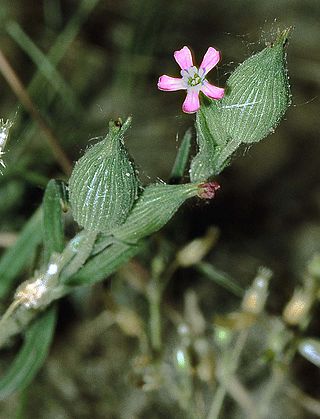
Silene conica is a species of flowering plant in the family Caryophyllaceae known by the common names striped corn catchfly and sand catchfly. It grows in dunes and sandy soils and is widespread in Europe and western Asia. It has an annual life history and produces self-compatible hermaphroditic flowers and occasional male-sterile flowers. Like other members of Silene section Conoimorpha, S. conica is readily recognizable based on its bright pink petals and the prominent, parallel veins on its calyx. In contrast to most flowering plants, S. conica appears to have a very rapid rate of mitochondrial mutation, and has the largest mitochondrial genome ever identified.

Silene is a flowering plant genus that has evolved a dioecious reproductive system. This is made possible through heteromorphic sex chromosomes expressed as XY. Silene recently evolved sex chromosomes 5-10 million years ago and are widely used by geneticists and biologists to study the mechanisms of sex determination since they are one of only 39 species across 14 families of angiosperm that possess sex-determining genes. Silene are studied because of their ability to produce offspring with a plethora of reproductive systems. The common inference drawn from such studies is that the sex of the offspring is determined by the Y chromosome.

Silene otites, called Spanish catchfly, is a species of flowering plant in the genus Silene, native to Europe and the Transcaucasus area, and introduced to Xinjiang in China. It varies its floral odors to attract mosquitoes and moths at night and flies and bees by day. It is dioecious, with separate male and female plants.
Gynomonoecy is defined as the presence of both female and hermaphrodite flowers on the same individual of a plant species. It is prevalent in Asteraceae but is poorly understood.
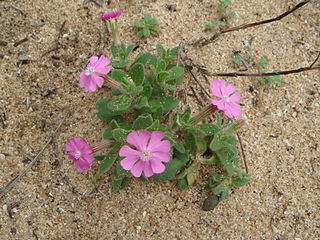
Silene littorea is a species of flowering plant in the family Caryophyllaceae. The species is an annual plant.
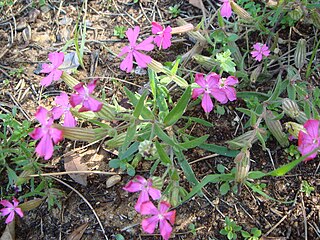
Silene stockenii is a species of flowering plant in the Caryophyllaceae first described in 1973. The specific epithet is named after Christopher Maitland Stocken, who discovered it in 1962 in Bornos. It is native to Spain, where it is endemic to grasslands growing in calcareous soil on formations made from calcarenite west of Cádiz in Andalusia. It is currently listed as critically endangered. In 1993, the number of individuals belonging to this species was estimated to be below 2000.
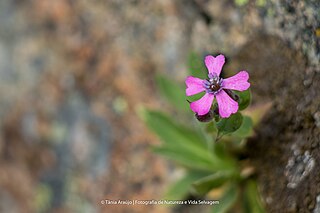
Silene acutifolia is a species of herb native to northwest Spain as well as central and northern Portugal. The species is polycarpic and usually grows in rocky environments.

Silene italica is a species of plant native to Southern Europe and parts of Asia. It is also introduced to parts of the United States and Northern Europe.
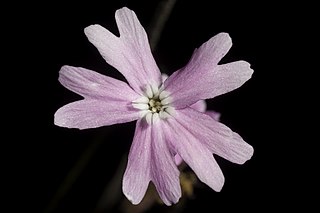
Silene akaisialpina is a species of plant native to Japan in the mountains of central Honshu. It has also been reported on the island of Hokkaido.
















